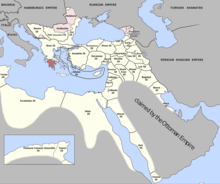Morea Eyalet
| Eyālet-i Mōrâ | |||||||||||||
|---|---|---|---|---|---|---|---|---|---|---|---|---|---|
| Eyalet of the Ottoman Empire | |||||||||||||
| 1661–1686 1715–1821 | |||||||||||||
 Morea Eyalet in 1795 | |||||||||||||
| Capital | Corinth, Nafplion, Tripolitza | ||||||||||||
| History | |||||||||||||
• Established | 1661 | ||||||||||||
| 1685/7 | |||||||||||||
| 1715 | |||||||||||||
| 1770 | |||||||||||||
| 1821 | |||||||||||||
| |||||||||||||
The Eyalet of the Morea (Template:Lang-ota)[1] was a first-level province (eyalet) of the Ottoman Empire, centred on the Peloponnese peninsula in southern Greece.
History
From the Ottoman conquest to the 17th century
The Ottoman Turks overran the Peloponnese between 1458–1460, conquering the last remnants of the Byzantine Empire, with the exception of the Venetian strongholds,[2] which were taken gradually over decades of intermittent Ottoman–Venetian Wars. Coron and Modon fell in 1500, and by 1540, the Ottoman conquest of the Peloponnese had been completed with the capture of Monemvasia and Nauplion.[3][4]
Upon its conquest, the peninsula was made a sanjak of the Rumelia Eyalet, with its capital first at Corinth (Turk. Kordos or Gördes), later in Leontari (Londari), Mystras (Mezistre or Misistire) and finally in Nauplion (Tr. Anaboli).[5] Since the 16th century, Mystras formed a separate sanjak, usually attached to the Eyalet of the Archipelago rather than Rumelia.[6]
Creation of the eyalet, Venetian interlude and second Ottoman period
Sometime in the mid-17th century, as attested by the traveller Evliya Çelebi, the Morea became the centre of a separate eyalet, with Patras (Ballibadra) as its capital.[7] The Venetians occupied the entire peninsula during the successful Morean War (1684–1699), establishing the "Kingdom of the Morea" (It. Regno di Morea) to rule the country. Venetian rule lasted until the Ottoman reconquest in 1715.[8]
The Morea Eyalet was re-established, headed by the Mora valesi, who until 1780 was a pasha of the first rank (with three horsetails) and held the title of vizier. After 1780 and until the Greek War of Independence, the province was headed by a muhassil. The pasha of the Morea was aided by a number of subordinate officials, including a Christian translator (dragoman), who was the senior Christian official of the province.[9] The capital was first at Nauplion, but after 1786 at Tripolitza (Tr. Trabliçe).[5]
The Moreote Christians rose against the Ottomans with Russian aid during the so-called "Orlov Revolt" of 1770, but it was swiftly and brutally suppressed. As a result, the total population decreased during this time, while the proportion of the Muslim element in it increased. Nevertheless, the privileges granted to the Orthodox population with the Treaty of Kuchuk-Kainarji, especially the right to trade under the Russian flag, led to a considerable economic flowering of the local Greeks, which, coupled with the increased cultural contacts with Western Europe (Modern Greek Enlightenment) and the inspiring ideals of the French Revolution, laid the groundwork for the Greek War of Independence.[9]
Administrative divisions
According to Evliya, at the time of his visit the eyalet comprised the sanjaks of Misistire, Aya Maura (Leucas), Aynabahti (Lepanto), Karli-Eli, Manya (Mani Peninsula) and Ballibadra (Patras), i.e. it encompassed also the portions of western and central Continental Greece.[7][10]
At the beginning of the 19th century, according to the French traveller François Pouqueville and the Austrian scholar Joseph von Hammer-Purgstall, the eyalet comprised the following sanjaks:[7]
- Mora, i.e. the pasha-sanjak around the capital, Tripolitza
- Anavarin (Navarino)
- Arkadya (Kyparissia)
- Aynabahti
- Ballibadra (Patras)
- Gastuni (Gastouni)
- Messalonghi (Missolonghi)
- Kordos, but by the time of Pouqeville's visit with Anaboli as capital
- Koron
- Misistire
- Moton (Modon)
- Pirgos (Pyrgos)
Throughout both Ottoman periods, Morea was also divided into a number of smaller districts (kazas, kadiluks or beyliks), whose number varied but was usually between 22 and 25, and reached 27 by 1784.[4][5] In the mid-17th century, when the Morea was still a sanjak, these were, according to Hajji Khalifa: Kordos, Arhos (Argos), Anaboli, Firina, Ayapetri (Agios Petros), Ruya, Manya (de facto free of Ottoman control), Kalavrita (Kalavryta), Kartina (Karytaina), Londari, Andrusa (Androusa), Koron, Motun, Anavarin, Arkadya (Kyparissia), Fanar (Fanari), Holomiç (Chlemoutsi), Voştiçe (Aigio), Ballibadra or Balye Badre. In addition, Misistra, Menceşe (Monemvasia) and Kalamata belonged to the sanjak of Misistire/Mezistre.[4][11]
References
- ^ "Some Provinces of the Ottoman Empire". Geonames.de. Retrieved 25 February 2013.
- ^ Kazhdan (1991), p. 1621
- ^ Bées & Savvides (1993), p. 239
- ^ a b c Zarinebaf, Bennet & Davis (2005), p. 21
- ^ a b c Bées & Savvides (1993), p. 238
- ^ Birken (1976), pp. 57, 106
- ^ a b c Birken (1976), pp. 57, 61–64
- ^ Bées & Savvides (1993), pp. 239–240
- ^ a b Bées & Savvides (1993), p. 240
- ^ Evliya Çelebi (2005), p. 49
- ^ Rumeli und Bosna, geographisch beschrieben, von Mustafa ben Abdalla Hadschi Chalfa. Aus dem Türkischen übersetzt von J. v. Hammer (in German). Vienna: Verlag des Kunst- und Industrie-Comptors. 1812. pp. 111–125.
Sources
- Bées, N.A.; Savvides, A. (1993). "Mora". The Encyclopedia of Islam, New Edition, Volume VII: Mif–Naz. Leiden and New York: BRILL. pp. 236–241. ISBN 90-04-09419-9.
- Birken, Andreas (1976). Die Provinzen des Osmanischen Reiches. Beihefte zum Tübinger Atlas des Vorderen Orients (in German). Vol. 13. Reichert. ISBN 9783920153568.
- Evliya Çelebi (2005). Εβλιγιά Τσελεμπί: Οδοιπορικό στην Ελλάδα (1668 - 1671) (in Greek). transl. by D. Loupis. Athens: Ekati. ISBN 960-7437-07-1.
{{cite book}}: Unknown parameter|trans_title=ignored (|trans-title=suggested) (help) - Kazhdan, Alexander, ed. (1991). Oxford Dictionary of Byzantium. Oxford University Press. ISBN 978-0-19-504652-6.
{{cite encyclopedia}}: Missing or empty|title=(help) - Zarinebaf, Fariba; Bennet, John; Davis, Jack L. (2005). A Historical and Economic Geography of Ottoman Greece: The Southwestern Morea in the 18th Century. Hesperia Supplement 34. The American School of Classical Studies at Athens. ISBN 0-87661-534-5.
